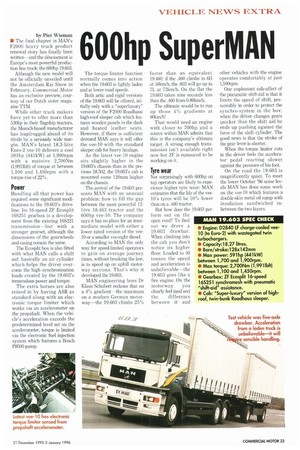600hp SuperMAN
Page 25

If you've noticed an error in this article please click here to report it so we can fix it.
by Piet Wieman • The final chapter in MAN's F2000 heavy truck product renewal story has finally been written—and the denouement is Europe's most powerful production line truck: the 600hp 19.603.
Although the new model will not be officially unveiled until the Amsterdam Rai Show in February, Commercial Motor has an exclusive preview, courtesy of our Dutch sister magazine yrm.
While other truck makers have yet to offer more than 530hp in their flagship tractors, the Munich-based manufacturer has leapfrogged ahead of its rivals by a seriously wide margin. MAN's latest 18.3-litre Etiro-2 vee-10 delivers a cool 591hp (441kW) at 1,900rpm with a massive 2,700Nm (1,9911bft) of torque at between 1,100 and 1,450rpm with a torque rise of 22%.
Power
Handling all that power has required some significant modifications to the 19.603's driveline. Its 16-speed ZF Ecosplit 16S251 gearbox is a development from the existing 165221 transmission—but with a stronger gearset, although the dimensions of the gearwheels and casing remain the same.
The Ecosplit box is also fitted with what MAN calls a shift aid: basically an air cylinder which helps the driver overcome the high synchronisation loads created by the 19.603's tremendous power and torque.
The extra horses are also reined in by having ASR as standard along with an electronic torque limiter which works via an accelerometer on the propshaft. When the vehicle's acceleration exceeds the predetermined level set on the accelerometer, torque is limited via the electronic fuel injection system which features a Bosch P8500 pump. The torque limiter function normally comes into action when the 19.603 is lightly laden and at lower road speeds.
Both artic and rigid versions of the 19.603 will be offered, initially only with a "superluxury" version of the F2000 Roadhaus high-roof sleeper cab which features wooden panels in the dash and heated leather seats. However, if there is sufficient demand MAN says it will offer the vee-10 with the standard sleeper cab for heavy haulage.
As the latest vee-10 engine sits slightly higher in the 19603's chassis than in the previous 18.502, the 19.603's cab is mounted some 120mm higher on the chassis.
The arrival of the 19.603 presents MAN with an unusual problem: how to fill the gap between the most powerful 12litre 18.463 tractor and the 600hp vee-10. The company says it has no plans for an intermediate model with either a lower rated version of the vee10 or a smaller vee-eight diesel.
According to MAN the only way for speed-limited operators to gain on average journey times, without breaking the law, is to speed up on uphill motorway sections. That's why it developed the 19.603.
MAN engineering boss Dr Klaus Schubert reckons that on a 4% gradient the maximum on a modern German motorway—the 19.603 climbs 25% faster than an equivalent 19.460: if the .460 climbs in 611 at 58km/h, the .603 will go up in 7L at 73km/h. On the flat the 19.603 takes nine seconds less than the .460 from 0-80ktn/h.
The ultimate would be to run up those 4% gradients at 80km/h!
That would need an engine with closer to 700hp and a source within MAN admits that this is the company's ultimate target. A strong enough transmission isn't available right now but ZF is rumoured to be working on it.
Tyre wear
Not surprisingly with 600hp on tap operators are likely to experience higher tyre wear: MAN estimates that the life of the vee10's tyres will be 10% lower than on a .460 tractor.
But how does the 19.603 perform out on the open road? To find out we drove a 19.603 drawbar. When climbing into the cab you don't notice its higher floor. Loaded to 40 tonnes the speed and acceleration is unbelievable—the 19.603 goes like a fire engine. On the motorway you clearly feel (and see) the difference between it and
other vehicles with the engine operates comfortably at just 1,10Orpm.
One unpleasant side-affect of the pneumatic shift-aid is that it limits the speed of shift, presumably in order to protect the synchro-system in the box: when the driver changes gears quicker than the shift aid he ends up pushing against the force of the shift cylinder. The good news is that the stroke of the gear lever is shorter.
When the torque limiter cuts in the driver feels the accelerator pedal reacting slower against the pressure of his foot.
On the road the 19.603 is magnificently quiet. To meet the lower October '96 noise levels MAN has done some work on the vee-10 which features a double-skin metal oil sump with insulation sandwiched inbetween the two layers.




























































































































